
 Felix George Arndt (May 20, 1889 to October 16, 1918) | |
 Compositions Compositions | |
|
1908
71st Regiment WaltzOnly One More [1] 1911
As Long As the Band Will Play [2]If That Ain't Love Wot Is? [3] When Sunday Rolls Around [3] It's Something That You Cannot Learn from Books [3] Night Time [3] Time Callahan [3] Don't Care for Nothin' But You [3] I'm Looking for an Heiress Who is Looking for an Earl [3] Somebody's Mother [3] Snow Time [4] 1912
When You Know Why [3]1913
Banjo Dance<Ev'ry Rose Reminds Me of You [3] Lucky in Love [3] The Toothache [5] 1914
A Symphonic Nightmare: Desecration Rag #1From Soup to Nuts Coquette Kakúda |
1914 (Cont.)
Love in JuneToots: Rag One-Step Maids of Athens: Musical [5,6] Alluring Lou Nurse, Nurse, Nurse 1915
Clover ClubApropos Nola 1916
An Operatic Nightmare: Desecration Rag #21917
Marionette1918
In the Shade of the Mango Tree [3]My Gal's Another Gal Like Galli-Curci [3] 1922 (Posth)
Nola (Song) [8]
1. w/J. George Frank
2. w/Harold Atteridge 3. w/Louis Weslyn 4. w/Bert Fitzgibbon 5. w/J. Delf 6. w/Henry Lodge 7. w/Carolyn Wells 8. w/James F. Burns |
 Discography Discography | |
|
1912
Campin' on de Old Suwanee [1]Florida Rag [1] Persiflage [1] The Smiler - A Joplin Rag Porto-Rico - Rag Intermezzo My Sumurun Girl The Merry-Go-Round The Haunting Rag 1914
Thanks for the Lobster [1]Notoriety Rag [1] Hacienda Society Tango Hesitation Waltz From Soup to Nuts Humoresque Rag Desecration Rag Too Much Ginger [1] The Smiler Rag Medley [1] Chinese Picnic [1] Old Folks Rag [1] Old Folks Rag (retake) [1] Too Much Trouble [1] Toots - One Step [2] Le Trousseau [2] Indianola Patrol - One Step [2] Love in June Go To It! [1] Kakúda [1] Azalea Waltz [2] Annie Laurie/Coming Through the Rye [3] Home Sweet Home [3] Entr'acte Gavotte [2] Old Folks at Home [3] Old Black Joe [3] When You and I were Young, Maggie [3] Silver Threads Among the Gold [3] Drink to Me Only With Thine Eyes [3] Woodland Sketches: To a Wild Rose [3] My Old Kentucky Home [3] Nearer My God to Thee [3] Stille Nacht, Heilige Nacht (Silent Night) 1915
The Original Fox Trot [1]I Wonder What Will William Tell [1] Woodland Sketches: At An Old Trysting Place [3] Whispering Hope [3] 1916
NolaAn Operatic Nightmare 1917
MarionetteHumoresque Valse Bleue Water Scenes/Narcissus
1. w/Van Eps Trio or Fred Van Eps
2. w/Dr. Clarence Penny, Mandolin 3. on Keyboard Celesta |
Matrix and Date
[Victor B-12237] 07/26/1912[Victor B-12238] 07/26/1912 [Victor B-12239] 07/26/1912 [Victor B-12300] 08/08/1912 [Victor B-12301] 08/08/1912 [Victor B-12302] 08/08/1912 [Victor B-12303] 08/08/1912 [Victor B-12304] 08/08/1912 [Victor B-14420] 02/05/1914 [Victor B-14493] 02/20/1914 [Victor B-14494] 02/20/1914 [Victor B-14502] 02/20/1914 [Victor B-14503] 02/20/1914 [Victor B-14541] 03/06/1914 [Victor B-14587] 03/19/1914 [Victor B-14588] 03/19/1914 [Victor B-14589] 03/19/1914 [Victor B-15093] 07/29/1914 [Victor C-15093] 09/04/1914 [Victor B-15094] 07/29/1914 [Victor B-15141] 08/24/1914 [Victor B-15142] 08/24/1914 [Victor B-15143] 08/24/1914 [Victor B-15144] 08/24/1914 [Victor B-15161] 08/31/1914 [Victor B-15162] 08/31/1914 [Victor B-15163] 08/31/1914 [Victor B-15375] 11/10/1914 [Victor B-15376] 11/10/1914 [Victor B-15377] 11/10/1914 [Victor B-15432] 11/25/1914 [Victor B-15433] 11/25/1914 [Victor B-15434] 11/25/1914 [Victor B-15435] 11/25/1914 [Victor B-15439] 11/30/1914 [Victor B-15440] 11/30/1914 [Victor B-15441] 11/30/1914 [Victor B-15558] 12/31/1914 [Victor B-15559] 12/31/1914 [Victor B-15633] 01/27/1915 [Victor B-15634] 01/27/1915 [Victor B-15635] 01/27/1915 [Victor B-17400] 03/30/1916 [Victor B-19238] 03/05/1917 [Victor B-19290] 03/19/1917 [Victor B-19706] 04/20/1917 |
 Rollography Rollography | |
|
A rollography is being considered for this entry. However, given the huge volume of Arndt's rolls, even if minimized to those recorded under his name, this is a daunting process that may take a while to complete. For now, you can view and search on scanned rolls at the following sites: Warren Trachtman's Roll Scans Robert Perry's Pianola Roll Scans Terry Smythe's Roll Scan Library | |
Felix Arndt, regarded by some as the earliest proponent of the novelty piano style, was born to royalty, at least in a sense. His mother, Charlotte Harpeur (5/1851), was born in Spain to a French father and Spanish mother. Charlotte was known as the Countess Fevrier of France, and was reportedly related to Napoleon III. (She was mistakenly listed as Carolyn in the 1910 census.) Felix's father, Andreas W. Hugo Arndt (2/1853), was a carpenter born in Switzerland. The couple married in Manhattan in 1888. Felix also had a younger sister, Charlotte A. Arndt (12/1890). Born in New York, Felix was educated in the New York City public school system, greatly improved as the influence of Tammany Hall was waning, and usually fostering those who wanted to play instruments in the requisite school band. He took up the piano on his own, but later sought out advanced training in harmony and theory. One of his professors was pianist Carl Lachmund, who was a follower of Franz Liszt.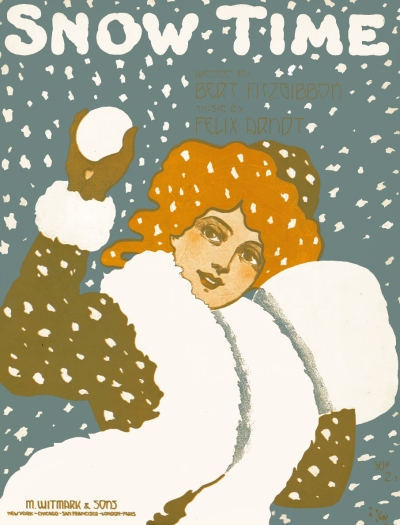 Carl's son Arno F. Lachmund would one day work indirectly with Felix while employed by Duo-Art.
Carl's son Arno F. Lachmund would one day work indirectly with Felix while employed by Duo-Art.
 Carl's son Arno F. Lachmund would one day work indirectly with Felix while employed by Duo-Art.
Carl's son Arno F. Lachmund would one day work indirectly with Felix while employed by Duo-Art.Once out of school, Arndt's talent for arranging was quickly recognized by publishers, and he got a job composing special material on demand for several years, including for vaudeville stars such as the husband and wife team of Nora Bayes and Jack Norworth, and often with fellow composer Gus Edwards (although specific titles have not surfaced to date and may have been disposed of after use). His steady gig for a time was as the organist for New York's famed Trinity Church, right on Wall Street and a focal point in the days following the WTC disaster of 2001. He was shown in 1910 as still living with his family, and as a musician working for a publisher. Charlotte was shown as a stenographer working for a publisher, possibly the same one.
Felix was teamed with Louis Weslyn in 1911, and they turned out a number of minor successes over the next three years. However, one of his more fortuitous breaks came in 1912 when Arndt joined banjoist Fred Van Eps and his brother Bill Van Eps on a second banjo to form the Van Eps Trio, the first of many such groups led by Fred. Van Eps had already been recording for Victor Records, so had no problem bringing Felix into the fold. When Fred first met Arndt, over a decade younger than himself, he was a fledgling arranger and demonstrator for publisher M. Witmark working for around $20 a week. Van Eps was impressed with his skill and style, and tried to recruit Felix against his European mother's objection, since she did not want him leaving a secure position to work as a performer. Fred told her that he would guarantee Felix $50 a week, but "if couldn't make $100 I didn't want him." She consented, and it launched a fruitful but short career for the talented youth.
Victor also accepted Felix as a soloist, and this started a flurry of recording activity over the next several years. Felix would cut at least 30 keyboard solo sides in addition to his recordings of the trio, and five with mandolin player Dr. Clarence Penny.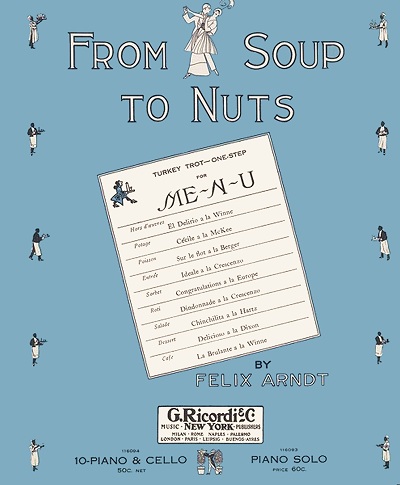 Many of the sides also featured Felix playing the delicate keyboard celesta. He also debuted many of his own compositions simultaneously on record and piano roll over the next few years. After several cuts in 1912 there were curiously no solo sides from 1913, but as it turns out, Felix was pretty busy.
Many of the sides also featured Felix playing the delicate keyboard celesta. He also debuted many of his own compositions simultaneously on record and piano roll over the next few years. After several cuts in 1912 there were curiously no solo sides from 1913, but as it turns out, Felix was pretty busy.
 Many of the sides also featured Felix playing the delicate keyboard celesta. He also debuted many of his own compositions simultaneously on record and piano roll over the next few years. After several cuts in 1912 there were curiously no solo sides from 1913, but as it turns out, Felix was pretty busy.
Many of the sides also featured Felix playing the delicate keyboard celesta. He also debuted many of his own compositions simultaneously on record and piano roll over the next few years. After several cuts in 1912 there were curiously no solo sides from 1913, but as it turns out, Felix was pretty busy.Another bit of good fortune came in 1913 when Arndt started at Universal Music Company during the advent of "hand-played" piano rolls. As announced in the Music Trade Review of March 15, 1913: "The Universal Music Co., 29 West Forty-second street, New York, is calling the attention of the trade to the fact that Felix Arndt has just signed a contract to compose, arrange and play for the Uni-Record. Felix Arndt needs no introduction to lovers of popular music, either as a player or composer, as his renditions are known from one end of the country to the other." Even though he was signed at first as an "exclusive" artists, Arndt soon managed to get work with other concerns as well.
Being a fine arranger and pianist, the position with Universal allowed him the opportunity to advance his skills when applied to other composer's works, and helped him in his compositions as well. The following year, Arndt also became a staff musician for Aeolian Hall, creating Duo-Art reproducing rolls in the Popular Music genre. In his nearly five years for the two companies, he reportedly created over 3,000 rolls, which would equate to three or four on an average workday. It should be noted that he was not confined to popular works only, taking on many well-known classics, operas, and even contemporary composers such as Claude Debussy in his own inimitable style. However, many of these rolls were sometimes re-released under multiple sub-labels, so that number was likely substantially smaller, yet still astonishing given the time frame.
It was during this period that he penned the first of a series of compositions that are now considered to be classic novelties, A Symphonic Nightmare: Desecration Rag (#1).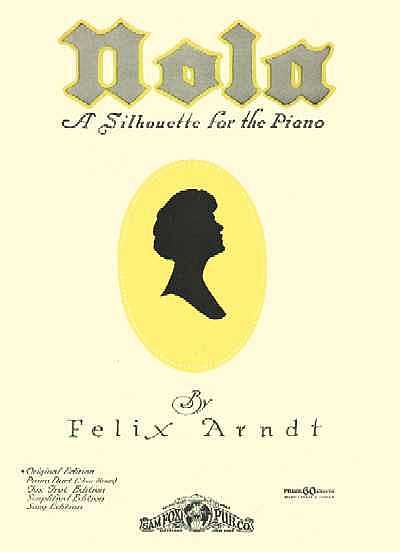 It is an amusing send up of well-known symphonic pieces in a complex syncopated format. This was followed by the unusual From Soup to Nuts, and a piece that would be the harbinger of genius yet to come, Marionette, although the latter would not be fully released until 1917. Felix was a charter member of ASCAP, founded by several musicians in 1914 in an effort to provide a focal registration point for protecting copyrights and distributing royalties.
It is an amusing send up of well-known symphonic pieces in a complex syncopated format. This was followed by the unusual From Soup to Nuts, and a piece that would be the harbinger of genius yet to come, Marionette, although the latter would not be fully released until 1917. Felix was a charter member of ASCAP, founded by several musicians in 1914 in an effort to provide a focal registration point for protecting copyrights and distributing royalties.
 It is an amusing send up of well-known symphonic pieces in a complex syncopated format. This was followed by the unusual From Soup to Nuts, and a piece that would be the harbinger of genius yet to come, Marionette, although the latter would not be fully released until 1917. Felix was a charter member of ASCAP, founded by several musicians in 1914 in an effort to provide a focal registration point for protecting copyrights and distributing royalties.
It is an amusing send up of well-known symphonic pieces in a complex syncopated format. This was followed by the unusual From Soup to Nuts, and a piece that would be the harbinger of genius yet to come, Marionette, although the latter would not be fully released until 1917. Felix was a charter member of ASCAP, founded by several musicians in 1914 in an effort to provide a focal registration point for protecting copyrights and distributing royalties.In early 1915 Felix met his famous muse, Nola Blanche Locke, a professional singer with the St. Louis symphony, and a vocal teacher and capable pianist as well. She was born in DeQueen, Arkansas, near Monroe, on July 11, 1889 to real-estate agent George Todd Locke and his wife Callie Blanche Dooley. Nola was in the middle of six children in the family of three girls and three boys, the youngest boy dying in infancy in 1900. George died a year later in 1901. Nola was on her own as of the 1910 census, living in St. Louis and likely working as a teacher at that time, having not yet been engaged by the Symphony. The circumstances of how she met Felix were outlined in the weekly Hearst newspaper insert magazine, The American Weekly, in the August 14, 1949 edition:
IT’S LIKE any piano,” the demonstrator was saying. “Just Insert the music roll here, push this lever, sit down and pump the pedals with your feet. Now, which if you girls would like to try it?’ The one who stepped forward was Nola Locke...
The year was 1915 and the mechanical marvel brought such artists as Paderewski, Godowsky and Hofmann right into the home. As the piano began to play the “Chanson Provencale,” Nola gaily imitated the pianist by moving her fingers accurately over the keys. Then she sang, in a clear, perfectly balanced coloratura. “It’s as though she were playing her own accompaniment,”’ the headmistress exclaimed. “Hasn't she a lovely voice?’ The demonstrator nodded violently; he had an idea. Would Nola consent to appear with the player in a concert hall? Would she? From her answer comes one of the most romantic chapters in the history of American music.
Days later, Nola stood in the wings of Aeolian Hall in New York. As she walked on the stage, she wasn’t a bit nervous, this high-spirited schoolgirl from St. Louis, but the enthusiastic applause of the audience bewildered her. She bowed, sat down, moved her fingers over the keys. In the middle of her aria, she rose and walked to the footlights, still singing. The electric piano went on playing alone. Sensation. Ovation. No novelty like it had ever been seen by New York audiences.
Backstage, after the triumph, the inventor of the [Metrostyle expression] player, Francis L. Young, said to Nola: “Now I'm going to take you to meet your invisible accompanist, the young musician who recorded the rolls. He was sitting in a box during your performance—and he’s the most interesting young man in New York.” Later, in Felix Arndt’s studio over the same concert building, Mr. Young introduced Nola and said, ‘‘Felix, give us a musical portrait of Miss Locke. Of what, in music, does she remind you?” Already hailed as the “King of syncopation,” Felix improvised a bar or two. the delighted Nola began to dance. The melody was captivating.
“Is that an engagement ring. asked Felix, pointing to Nola's finger when they were alone. “Yes.” Nola admitted. “And so is this one on this finger. I have a third one at home,”’ Felix protested, laughingly, but his eyes were so serious that Nola sent all three rings back to their donors. The next morning, Nola's maid awakened her. “There’s a pale young man downstairs. Handsome, too. Wants to see you. very important.” It was Felix. He had stayed up all night to finish the manuscript of “Nola” which... still occupies a unique place in American music.
SThe piece, of course, was Nola - A Silhouette for the Piano. A lilting tune made up largely of interesting patterns, and melodic lines that utilize both hands and span pretty much the entire keyboard, it was a much-admired template for what would become the genre of novelty piano in the 1920s. Copyrighted in late 1915, it was first published and recorded early in 1916. A later attempt to turn it into a relatively unsingable song version with lyrics added by James F. Burns was met with lukewarm response, the difficult pairing proven by a vocal recording of the piece. The romance story continues:
The composition was an engagement present, although neither was bold enough to say what was in their hearts. They went everywhere together — the opera, concerts, dinner parties. One night as he took her home. he said, “Will you? If only to say good-night and good-morning—like this.” Then he took her in his arms and kissed her. At the time of this proposal, the world was at war. Nino Antonini, the sculptor and Felix’s best friend, had already been called up. Felix and Nola, whose name was now an American by-word, were married in January 1916.
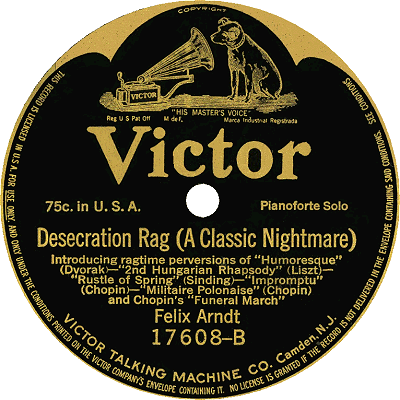
Continuing with his recording career, Felix performed both on record and live with variations of the Van Eps group, but at some point pianist Frank Edgar Banta started to fill in from time to time. According to Van Eps, Felix started to have trouble with his hands for some unknown reason, which made his live performances less consistent. Banta would eventually take over the piano spot in the group by 1916, partially at the insistence of Victor management who liked that particular combination. However, it was over the next two years from 1916 to 1918 that Felix really started to find his niche as a composer as well as a performer and arranger on piano roll, which could forgive any issues he had with controlling his hands. There was a second Desecration, An Operatic Nightmare: Desecration Rag #2 (the first was renumbered at this time), and a nice dance piece titled Clover Club,which had also been copyrighted in 1915. On some of the many rolls for which Felix applied his flying fingers, Nola also accompanied him and got credit for their duets. As for their married life, picking up in 1916:
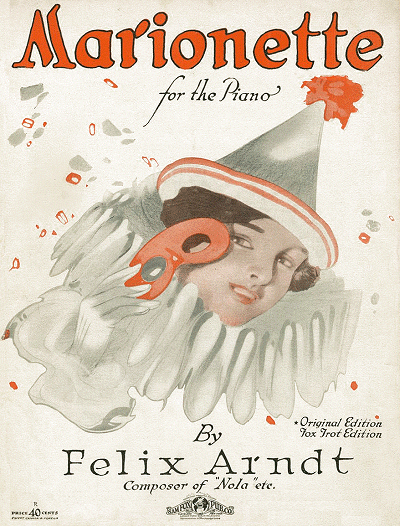
Their honeymoon was deferred until the following summer when they took a cottage on Fire Island. That winter Nola appeared in concerts in New York while Felix composed and recorded for the player manufacturer... The next summer at Harmon-on-Hudson was quiet except for the capture of a convict, escaped from Sing Sing, who used their studio for a hideout.
Right around the time of World War I was when young George Gershwin looked briefly to Arndt as a mentor of sorts. Felix likely got George his job with Aeolian Hall on 42nd Street in Manhattan in early 1916, potentially inspiring or even contributing a bit to the single rag that Gershwin wrote, Rialto Ripples. It has been suggested that Felix may have introduced George to his friend Irving Caesar, with which Gershwin would later pen his first and biggest hit, Swanee.
Felix's 1917 draft card shows him as an employee of Aeolian, and the sole support for Nola and her mother. His parents were still in Manhattan, and his sister Charlotte had recently married Alex Alexander. They subsequently had a daughter in 1918 named Elaine, and continued to live with Hugo and Charlotte for some time. On January 1, 1918, Felix added yet another notch on the ladder of success when he started with the now-dominant QRS piano roll company. They were also fortunate to have signed him exclusively to their label. He put his own full-page announcement under his portrait in the trades in February, 1918:
To the Music Industry:
After six years' experience recording for different roll cutters, I have come to the conclusion that there is a wonderful field for this line of work and owing to the Q R S Company's various line of rolls and complete organization, my best interests lie in recording for them exclusively, except, of course, that I shall continue to play for the Victor Talking Machine Company.
I wish to take this opportunity of thanking you, my friends, who have been so kind as to express your appreciation of my work and believe that this new arrangement will offer greater possibilities for us both.
Sincerely, Felix Arndt.
Throughout 1918 Arndt turned out a torrent of rolls with dynamic arrangements. There were some issues of the trade papers in which his name might be seen associated with four different companies on the same page. Overall, he had recorded hits for Universal (including their Uni-Record line), Aeolian (including their Duo-Art, Metro-Style Themodist and Metro-Art lines), the Wilcox and White Company (including their Angelus line), the A.B. Chase Reproducing Piano Company,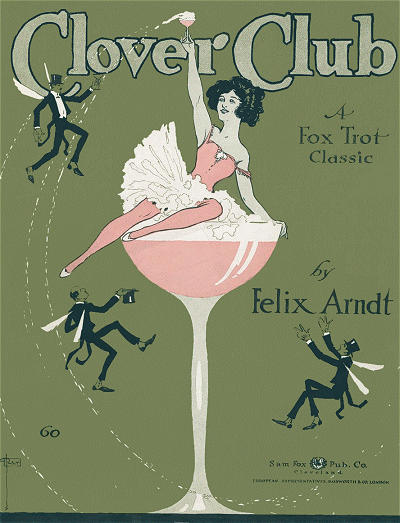 Perfection and QRS. Other companies featuring his work would tout him as the well-known player of rolls, even though he was working for the competition. The interview with Nola picks up the story once again:
Perfection and QRS. Other companies featuring his work would tout him as the well-known player of rolls, even though he was working for the competition. The interview with Nola picks up the story once again:
 Perfection and QRS. Other companies featuring his work would tout him as the well-known player of rolls, even though he was working for the competition. The interview with Nola picks up the story once again:
Perfection and QRS. Other companies featuring his work would tout him as the well-known player of rolls, even though he was working for the competition. The interview with Nola picks up the story once again:The third summer, 1918, was spent again at Harmon, where they received word that Nino Antonini had been killed in action. Felix was asked to go to New York to identify the body when it arrived from France. He returned from the painful errand one Sunday night in October. A farewell party was In progress. Felix didn’t talk much that evening, but played a great deal. When he and Nola were alone that night, he said, ‘Let's Stay until the leaves fall.” Next morning, Felix was ill — it was influenza, the “black plague” of 1918. By noon Wednesday, the leaves began to fall and a “Strange light,” as Nola described it, seemed to leave Felix. He died that night. He was [29] years old.
Then the 1918 Spanish Flu pandemic struck the world, and New York City was hit hard. According to the account in the Music Trade Review of October 26, 1918: "Mr. Arndt contracted cold on October 8, which developed into pneumonia, causing his death on October 16." The final analysis was that his system was weakened, and the influenza quickly overtook him at that point. This deadly sickness deprived the world of Felix Arndt shortly before WWI had ended. Arndt was interred at Sleepy Hollow Cemetery in Tarrytown, New York.
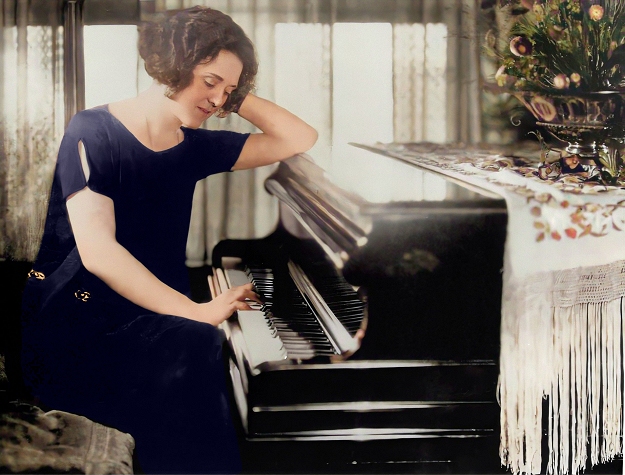 |
“Three short years,” Nola Arndt reminisced recently in her Steinway Hall studio in New York where she coaches in voice, piano and dramatics. “But such music as you’ve never heard. Felix made every day a surprise. Not only ‘Nola.’ which follows me wherever I go, but everything he did was perfection. “We had so much to share—beauty enough for a lifetime. Felix’s spirit was so rich. have lived on it all these years. With his Spirit, the whole world would sing.”
Nola went on with her life, and interestingly enough was known to have lived for a time with their mutual friend Caesar. Following her late husband's lead in the music business, Nola wrote a few songs of her own, and contributed the lyrics to Nobody Loves Me Now by Billy Tracey in 1922. While not readily found in the 1920 census, she was located in 1930 married to a Russian immigrant construction company president, Henry Mandel, working as a musician doing private concerts. Another song with lyrics by Nola appeared in 1938, Mia Cara (My Dear) with Oscar Malanga. From the late 1940s into the 1950s Nola worked as a music and drama coach in New York City. Little is known about the remainder of her life. Nola died in Manhattan on July 19, 1977. She was buried with her first love in the Sleepy Hollow Cemetery in Tarrytown.
As for her namesake composition, it continued to grow in popularity for decades after Felix's death. As noted in the February 28, 1925 edition of the Music Trade Review:
Composition by the Late Felix Arndt Continues to Grow in Favor Despite Long Time Since Published
"Nola," which has found such favor as a foxtrot with dance orchestras, theatres and in photoplay houses during the past season and also as a solo number by concert artists and in other is the work of the late Felix Arndt. As a piano silhouette it was recorded on the Victor records in 1915 and was first released in sheet music form by the present publisher, Sam Fox Publishing Co., Cleveland, Ohio, at that time.
The popularity of the number was immediate, demonstrating that the public, while favoring popular music, appreciates compositions of the better type.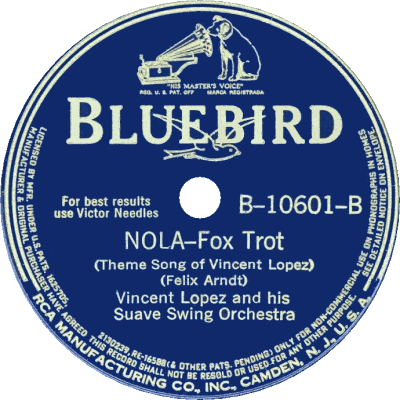 The original sales on this number were also produced by the renditions of pianists who gave it its initial popularity and who successfully presented it in the same manner as that of the composer.
The original sales on this number were also produced by the renditions of pianists who gave it its initial popularity and who successfully presented it in the same manner as that of the composer.
 The original sales on this number were also produced by the renditions of pianists who gave it its initial popularity and who successfully presented it in the same manner as that of the composer.
The original sales on this number were also produced by the renditions of pianists who gave it its initial popularity and who successfully presented it in the same manner as that of the composer.In 1922 Vincent Lopez and His Hotel Pennsylvania Orchestra rendered "Nola" as a fox-trot for the first time and later it was one of their features by radio. This quickly established "Nola" as a dance number and the publisher immediately forwarded orchestrations in fox-trot time to the leading orchestra leaders in all parts of the country. It undoubtedly became the outstanding instrumental hit of 1922 and the early part of 1923 and, of course, continues to maintain much of its popularity.
In 1923 Adelaide and Hughes, Florence Walton and Maurice and Lenora Hughes took up "Nola" as a special feature dance number. This brought further popularity to this offering. Bill Baker used it in the Music Box Revue for a full season. George Carey, xylophone soloist of Sousa's band, and the popular pianists, Roy Bargy, Frank Banta, Joseph Daily, as well as Frederick Fradkin, the solo violinist, played the number with unusual success. The latter also recorded the number with his own original arrangement for Brunswick records. Jascha Gurewich, the saxophone virtuoso, has proclaimed this number the greatest instrumental novelty ever written and many other outstanding artists seem to have a similar opinion.
The publisher is firmly of the belief that 'Nola' has not reached its peak and is anticipating that before the year is over the demand and sales for this charming composition will have increased double to what they are at the present time.
Nola managed to remain in print throughout the 20th century, selling millions of copies to hopeful pianists who wanted to try and catch that unique style. It was available as a popular piano duet as well. Overall the piece became perhaps the best seller in the catalog of Sam Fox who also had acquired many other Arndt compositions. By the late 1920s, Lopez had made it his theme song, preserving his arrangement on film in 1932 in the first of the Big Broadcast films and giving it constant radio exposure as well. A quickly rendered performance of it was heard in the orchestra introduction in the 1930 two-strip Technicolor film King of Jazz, starring Paul Whiteman and his orchestra. Guitarist Les Paul even had a top-ten with it in the 1950s using his revolutionary multi-tracking guitar recording technique. In the 21st century pianist Sue Keller has become associated with the tune, which was a favorite of her mother.
Arndt's music and style were most certainly influential on a number of composers of the 1920s, and they help to provide us a continuation of his legacy and the amazing potential he possessed.